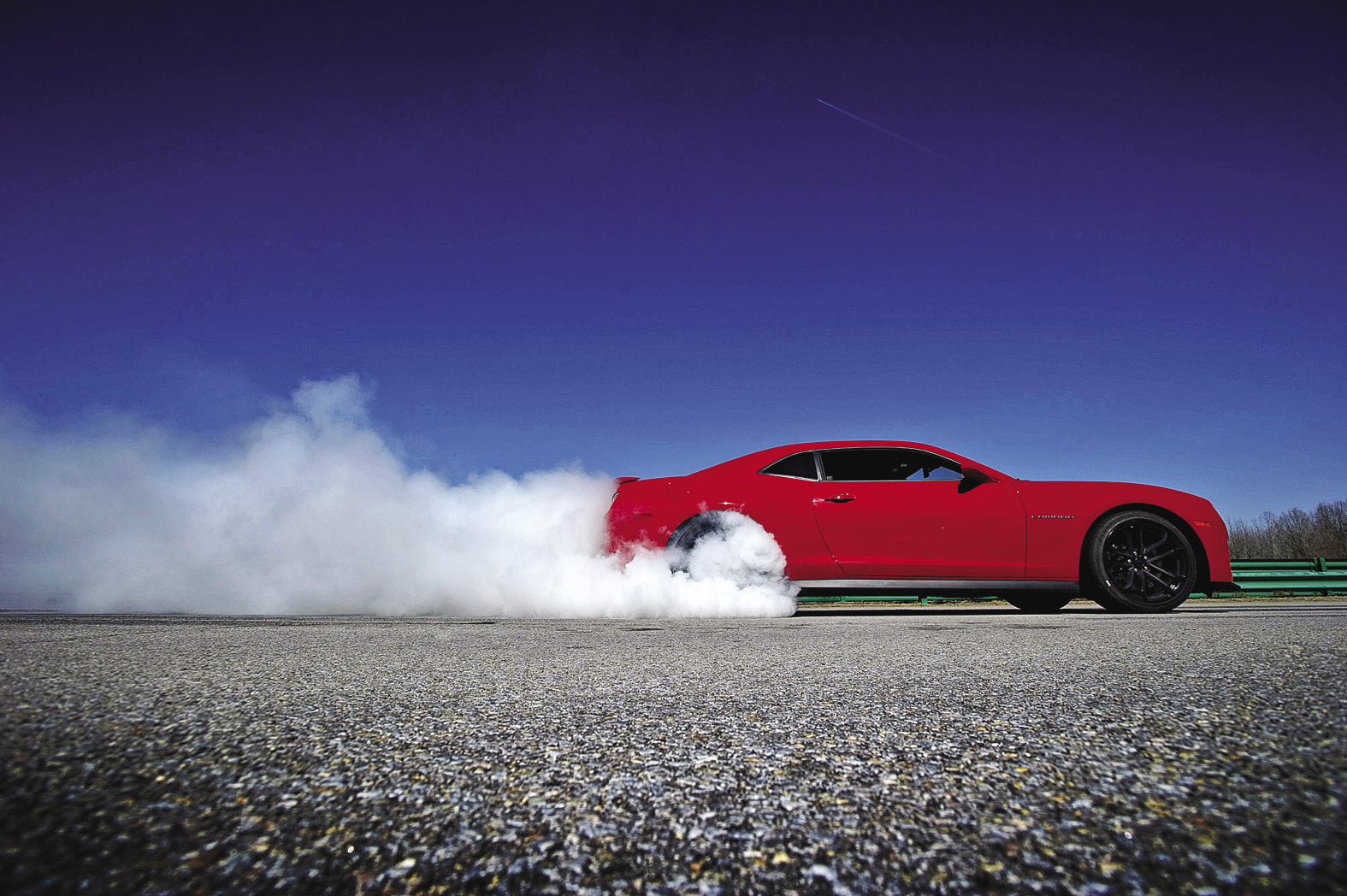Impressions
Because the ZL1 is a hulking muscle car, one accepts certain tradeoffs the minute he or she grabs the door handle – the fun does come at a bit of a price, after all.
For example, the seating position is bunker-like, low-slung with high doors and small windows. Rearward visibility is limited, with large blind spots, typical for cars of this ilk. A fellow scribe said it was like, “riding in a bathtub,” albeit a really fast and powerful bathtub.
The interior trim materials are better than what one would find in lesser Camaros, and the amount of gadgetry has been suitably increased – although we’re not sure how many buyers will actually use the pod of performance gauges in the centre stack for anything other than visual entertainment – but the ZL1 isn’t a Porsche or a BMW, so buyers shouldn’t be expecting anything too luxurious.
The dash and instrument panel still features plenty of hard plastic, and the chunky climate control knobs looked a little low rent. We hasten to add that they worked fine, but didn’t exactly exude a look of precision.
We were quite impressed with the seats and the overall driving position, however, (rearward visibility issues notwithstanding) and the optional suede package (seat and dash inserts, shift knob and steering wheel) felt like it was of a high quality and added to the performance feel. The wheel wasn’t too big or small and we liked the sporty feel of the stitched shift knob.
Late February might be cold and miserable where we come from, but in southern Virginia, the temperatures are much more hospitable. The mercury was reaching the upper teens during the two days we were on site, and there was no evidence of snow to be found anywhere. Milder winters certainly made for better driving conditions on area roads, which were almost completely free of cracks, bumps and broken asphalt, unlike the weatherbeaten roads in and around Toronto. For country roads far off the beaten path, they were remarkably smooth. The ZL1 proved to be quite hospitable on these roads, and the pleasant sounding growl of the exhaust made for plenty of fun driving.
But the real fun was at the track, where the ZL1 really shines. We spent the better part of a day wringing out both manual and automatic versions of the car on the undulating VIR tarmac, and came away mightily impressed with the car’s performance bonafides.
It took a few laps to get used to the immense power the ZL1 puts down at launch – the launch control was definitely helpful in that regard – and the gobs of torque that wanted to snap the rear end out in just about every turn. Once we had a feel for the ZL1 – and the somewhat tricky VIR track – flinging it around the 17- turn circuit was a lot of fun.
We kept the Performance Traction settings in the mid-range (Modes 2-3) at the behest of GM, which still enabled us to get a feel for the ZL1’s handling characteristics, while taking advantage of the LSA’s immense power delivery. While some scribes undoubtedly turned everything off, we weren’t tempted to do so after seeing photos of a car that went off track on the first day, crumpling the front end of a sharp looking lava orange tester in the process. We’re not keen on footing massive repair bills.
 It goes without saying that with most performance cars, you need a manual transmission to wring the most out of it, and we found this to be true with the ZL1 as well. The 6-speed manual Tremec gearbox worked flawlessly, and seemed well-suited to maximize the beastly LSA engine. The clutch pedal feel was quite good and the short throw shifter made gear selection a breeze.
It goes without saying that with most performance cars, you need a manual transmission to wring the most out of it, and we found this to be true with the ZL1 as well. The 6-speed manual Tremec gearbox worked flawlessly, and seemed well-suited to maximize the beastly LSA engine. The clutch pedal feel was quite good and the short throw shifter made gear selection a breeze.
The Hydra-Matic transmission worked fine also, but made the car feel a bit more lethargic and numb – we couldn’t get the power down in the same manner and weren’t always happy with the shift pattern the ECU employed on track. We concede that this is unlikely to be much of an issue in day-to-day commuting on the highway or cruising on city streets where the car won’t be driven nearly as hard.
One aspect of the ZL1 that owners will appreciate whether they’re on track or lurching through rush hour traffic is the immense stopping power of the Brembo brakes. We overshot our braking zone a few times – dropped a couple of wheels off the track, too – and the brakes saved us every time. They’re more than adequate to handle any normal day-to-day driving condition an owner might find him or herself in.
During the multimedia presentation GM made to the assembled media at the track on the night we arrived, an executive put up a slide comparing the ZL1’s price and performance numbers with those of some other well-known European sports cars. None of the other three cars were priced within $50,000 (US) of the ZL1, nor did they produce as much horsepower or torque. Two of the three don’t offer Magnetic Ride as an option either.
Perhaps more than anything else, this is what GM can really use to entice prospective buyers into Chevrolet showrooms to give the ZL1 a long, serious look: value for money.
The ZL1 starts at $58,000, and save for a handful of mostly appearance-related options (suede package, striping kit, sunroof, etc.), comes completely loaded from the factory. The only serious mechanical option is the automatic transmission, which many buyers are likely to forego.
A locked and loaded, track-ready car packing 580 horsepower for less than $60,000?
Sign us up.

Specifications
Price: $58,000 (base)
Engine: 6.2L LSA Supercharged and Intercooled V8
Output: 580 hp @ 6,100 rpm; 566 lbs.-ft torque @ 3,800 rpm
Platform: FR
Fuel Consumption (manufacturer): N/A (at press time)

- << Prev
- Next






















